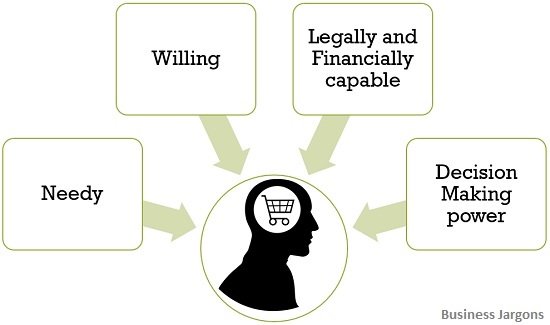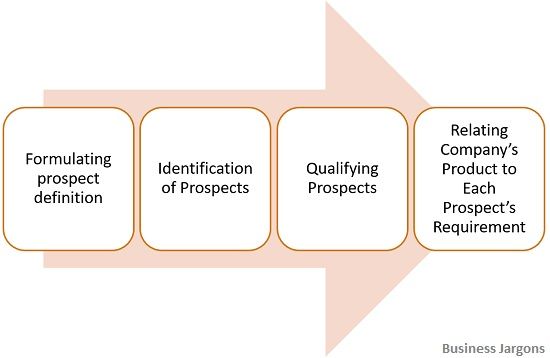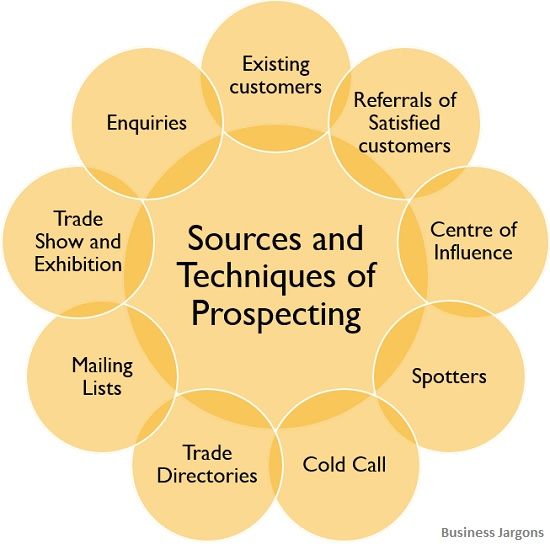Definition: In the process of sales, prospecting accounts for the first step that involves finding out promising customers, i.e. prospects, from the pool of leads, so as to locate the qualified potential buyer. It aims at creating a directory of potential customers and communicating with them in an orderly manner, so as to convert them into actual customers.
Basically, selling is a six-step process, which starts with sales prospecting and qualifying, and followed by The Preparation, The Presentation, Handling Objectives, Closing the Sale and Follow-up.
Prior to planning a sale, what a salesperson does is – they carry out research so as to look for the customers or clients who are likely to be interested in the product. This is what prospecting is all about, which acts as the base for the entire sales process.
Who is a Prospect?
A prospect is nothing but a qualified lead, who may turn into a potential customer, as they possess certain predefined characteristics, i.e. they are ascertained to be ready, able and willing to buy the product or service.
Steps in Prospecting
In simple words, prospecting means to develop new business opportunities by searching for and qualifying new customers or buyers for the company’s offerings. The steps involved in prospecting process are:
- Formulating prospect definition: This means that the salesperson needs to check if the prospective customer has the financial capacity, willingness, readiness and authority to buy. It is a sheer wastage of efforts and time of the salespersons if they attempt to sell to those individuals, who are not in need of the product, as well as they can’t afford it, because they try to sell the product or service to the wrong person.
- Identification of Prospects: After the prospects are defined, now the sales personnel gathers information from various available sources to identify the names of probable prospects or suspects. It is a challenging task, which involves the elimination of non-buyers, i.e. suspects from the list.

- Qualifying Prospects: Qualifying prospects means to ascertain if they are viable prospects or not. Once the information relating to the tentative prospects are gathered, it is simple to anticipate the possible requirement of each tentative prospect for the product offered by the company.

- Relating Company’s Products to Each Prospect’s Requirements: The prospecting process ends with creating the strategy to approach the prospect, which is possible only when the requirements of each prospect are ascertained from the information obtained.All those points which might be useful to convince the prospect for the product are selected, out of the information available, and the presentation of the salesperson is customized, accordingly.It also provides a clear understanding of the objections or questions which the prospect might have about the product or the company
Prospecting skills lead to productive selling. Therefore, sales personnel who spend very less time in prospecting, often invest their maximum time in calling non-prospects.
Contrastingly, sales personnel who excel in prospecting use their time and energy productively, by giving complete attention to those leads, who are interested as well as willing to buy.
Sources and Technique of Prospecting
The various sources and techniques of prospecting are discussed as under:
- Existing customers: As the name itself signifies, these are the present customers of the company who are satisfied with the company’s product and services. Hence, it is a lot easier to sell additional items to the existing buyers rather than approaching new customers.
- Referrals of Satisfied Customers: Otherwise called as endless chain, this method employs satisfied customers or clients of the company as the source of referrals, wherein the sales personnel may request their happy and satisfied customers, the names of the friends, relatives, and acquaintances, who are also willing to buy the product. And, the sales personnel would reach out to those people and make sales to them, and try to obtain new referrals.
- Centre of Influence: It is a prospecting technique which uses referrals, wherein the centre of influence implies a person that possess information about other persons or can easily influence them. It may include housewives, bankers, agents, political leaders, etc. Centre of influence assists the salesperson in finding out valid prospects.
- Spotters: These are sales trainees, who are used by the companies in identifying prospective customers.
- Cold Call: In this technique, the salesperson reaches the tentative prospect and introduces himself or herself to them and asks if they need such a product or service and also provides information about the benefits and quality of the product.
- Trade Directories: Directories can also be used to search for prospective customers. Salespersons can make use of directories of trade associations, professional societies, chamber of commerce, social organizations, etc. and contact their members.
- Mailing Lists: There are a number of organizations which provide lists of persons and companies for mailing purposes.
- Trade Shows and Exhibitions: Participating in trade shows and exhibitions is a unique technique to reach out prospective buyers while advertising and promoting their product or service, along with gaining information about the market, competitors, etc.
- Enquiries: Many customers call or visit the company’s outlet to get some information about the product, and every company maintains a database of those enquiries, for selling purposes, which also acts as a good source of prospecting.
In a nutshell, prospecting is the initial stage wherein search for the potential prospects is undertaken. Of these potential prospects, the ones who appear interested and also express their desire to go further, often proceed to the next level of the sales pipeline until they turn out as revenue-generating customers.

Louis Tiebu says
Good material. It has been helpful for my carrier as a relationship office